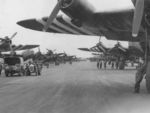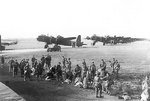Stirling
| Country | United Kingdom |
| Manufacturer | Short Brothers plc |
| Primary Role | Heavy Bomber |
| Maiden Flight | 14 May 1939 |
Contributor: C. Peter Chen
ww2dbaseThe Stirling heavy bombers were the result of the 1936 British Air Ministry Specification B.12/36. Shorts, the manufacturer, submitted the winning design that was actually modified from an existing four-engine design; the appeal for the Air Ministry was that, by basing the new bomber design on an existing one, production would be able to start quickly. After a first test prototype code named S.31 which first flew on 19 Sep 1938, the design was tweaked, and a new prototype code named S.29 took flight on 14 May 1939; this second design was to become the first of the Stirling bombers. On the maiden flight on 14 May 1939, the prototype's brakes failed, causing the aircraft to go off the runway during landing, collapsing the landing gear. The problem was corrected by adding much stronger and heavier struts. By the time the design entered production in 1939, it was clear that the Stirling bombers were powerful aircraft with excellent payload-range ratio.
ww2dbaseAlthough production began in 1939, Stirling bombers were not operational until Jan 1941. The first mission they embarked on was with No. 7 Squadron Royal Air Force on 10 Feb 1941, where three aircraft flew a bombing mission over fuel storage tanks in Rotterdam in the Netherlands. Beginning in spring 1942, they began to be used in greater numbers, and by May 1943, air raids over Germany involving over 100 Stirling bombers at once were being conducted. Stirling crews were reporting that, with the strong wing structure, they were able to out-turn German Ju 88 and Me 110 night fighters, something that other heavy bombers like the Lancaster and Halifax models could not do. Pilot Murray Peden of No. 214 RAF Squadron flatly described the Stirling as "one of the finest aircraft ever built", as noted in David Bashow's book No Prouder Place. However, the design was not without weaknesses, one of which was the low service ceiling, which exposed Stirling bombers to more anti-aircraft fire from the ground.
ww2dbaseAlthough Stirling bombers were designed to carry a heavy bomb load, two structural dividers running down the middle of the bomb bay limited the size of the bombs that could be loaded internally. As a result, as the RAF began using bombers larger than 907kg, Stirling bombers slowly lost their usefulness and were withdrawn from front line duties beginning in 1943. Their new duties include laying mines outside German ports, delivering special operations agents or paratroopers behind enemy lines, and towing gliders.
ww2dbaseIn service with RAF's Bomber Command between 1941 and 1945, Stirling bombers flew 14,500 operations and dropped 27,000 tons of bombs. 582 were lost in action and 119 were lost through other means out of a total of 2,383 built.
ww2dbaseSource: Wikipedia.
Last Major Revision: Jul 2007
Stirling Timeline
| 10 Feb 1941 | The Stirling aircraft made its operational debut as bombers of No. 7 Squadron RAF bombed oil storage facilities at Rotterdam, the Netherlands. |
| 8 Sep 1944 | RAF Bomber Command's last operation with the Short Stirling bomber was made by No. 148 Squadron against Le Havre, France. The Stirling bombers would then be relegated to troop-transport and glider tug missions only. |
SPECIFICATIONS
Stirling I
| Machinery | Four Bristol Hercules II radial engines rated at 1,375hp each |
| Armament | 2x7.7mm nose Browning machine guns, 4x7.7mm tail Browning machine guns, 2x7.7mm dorsal Browning machine guns, 8,164kg of bombs internally |
| Crew | 7 |
| Span | 30.20 m |
| Length | 26.60 m |
| Height | 8.80 m |
| Wing Area | 135.60 m² |
| Weight, Empty | 19,950 kg |
| Weight, Loaded | 26,940 kg |
| Weight, Maximum | 31,750 kg |
| Speed, Maximum | 410 km/h |
| Rate of Climb | 4.00 m/s |
| Service Ceiling | 5,030 m |
| Range, Normal | 3,750 km |
Photographs
 |  |  |  |
Did you enjoy this article or find this article helpful? If so, please consider supporting us on Patreon. Even $1 per month will go a long way! Thank you. Share this article with your friends: Stay updated with WW2DB: |
Visitor Submitted Comments
7 Jul 2016 12:58:42 PM
I think your comments on Coastal Command are correct. Bomber Command was probably the stumbling block. The Halifax would have been an excellent addition to the search for U-boats and surface warships, even with its 3000 mile range. The North Atlantic can get very wide at times. Maybe this is what BC was daunted by.
13 Jul 2017 02:04:00 AM
Hi, I request permission to add your photo of a Stirling being rearmed to my father's book (soon to be printed in a run of 100 copies). He was a decorated NZ Stirling pilot in 214 Sqn, shot down and became a POW but escaped 5 times. He died 10 yrs ago but wrote his epic story over the previous 10 years. Thank-you!!!!!!
15 Apr 2019 02:17:39 PM
Hi there ive just ive returned from a trip near the spainish french border where ive come across a small collection of Stirling parts recorvered from a crash site i believe to be near a village called lannars,can anyone help out with any details of lost aircraft in that area please.
13 Nov 2019 02:28:29 AM
I've been researching for a while on the landing gear of the Short Stirling. Would you have any information on the specifics of the size of the wheel assembly as I plan to draw it out on SolidWorks as part of a project.
28 May 2021 06:50:16 AM
I have a set of stirling access ladders
All visitor submitted comments are opinions of those making the submissions and do not reflect views of WW2DB.
- » Wreck of USS Edsall Found (14 Nov 2024)
- » Autumn 2024 Fundraiser (7 Nov 2024)
- » Nobel Peace Prize for the Atomic Bomb Survivors Organization (11 Oct 2024)
- » Wreck of USS Stewart/DD-224 Found (2 Oct 2024)
- » See all news
- » 1,150 biographies
- » 337 events
- » 43,917 timeline entries
- » 1,241 ships
- » 350 aircraft models
- » 207 vehicle models
- » 374 weapon models
- » 123 historical documents
- » 260 facilities
- » 470 book reviews
- » 28,544 photos
- » 432 maps
Lt. Gen. Lewis B. "Chesty" Puller, at Guadalcanal
Please consider supporting us on Patreon. Even $1 a month will go a long way. Thank you!
Or, please support us by purchasing some WW2DB merchandise at TeeSpring, Thank you!
21 Jun 2016 09:54:59 PM
Just thinking, they never considered it for the Maritime role (Coastal Command). It had the range (Spec called for 3,000 miles with 4,000 Lb bomb load). Good manoeuvrability (for attacking subs). A proper place to fit a centimetric radar scanner (a belly turret position was built in). And its lowish service ceiling would have been no problem over the Atlantic. I think Bomber Command was the stumbling block.